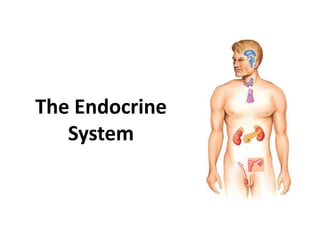
Endocrine system overview - HS Anatomy and Physiology
- 2. Let’s watch a video about it first: https://www.youtube.com/watch?v=WVrlHH14q3 o While we are watching the video record: 1. The 8 endocrine organs discussed in the video 2. At least one corresponding hormone to each gland
- 3. 3 • The endocrine system is made up of a network of ductless glands. • These glands secrete hormones to regulate many internal bodily functions including growth and metabolism. • Simply put, the endocrine system is a network of glands that secrete chemicals called hormones to help your body function properly. • Hormones are chemical signals that coordinate a range of bodily functions. Overview of the Endocrine System
- 4. 4 • Purely endocrine organs – Pituitary gland – Pineal gland – Thyroid gland – Parathyroid glands – Adrenal: 2 glands • Cortex • Medulla • Endocrine cells in other organs – Pancreas – Thymus – Gonads – Hypothalamus Endocrine Organs
- 5. Not the EXOCRINE Glands • There are another category of bodily secretions that leave glands via tubes or ducts that travel to the surface of the body. These are called exocrine glands. • Examples: sweat glands secrete sweat and salivary glands secrete saliva. NOT the EXOCRINE System
- 6. Hormones are messenger molecules • Circulate in the blood • Act on distant target cells • Target cells respond to the hormones for which they have receptors • The effects are dependent on the programmed response of the target cells • Hormones are just molecular triggers Basic categories of hormones • Amino acid based: modified amino acids (or amines), peptides (short chains of amino acids), and proteins (long chains of amino acids) • Steroids: lipid molecules derived from cholesterol What are Hormones?
- 7. Role of the Pituitary • Called Master Gland because hormones of the pituitary gland help regulate the functions of other endocrine glands. • The pituitary gland has two parts—the anterior lobe and posterior lobe—that have two very separate functions. • The hypothalamus sends signals to the pituitary to release or inhibit pituitary hormone production.
- 8. Role of the Pituitary (lobes) • The anterior lobe of the pituitary receives signals from the hypothalamus • Responds by sending out the appropriate hormone to other endocrine glands that causes them to act. Adrenocorticotropic hormone (ACTH) Growth hormone (GH) Thyroid-stimulating hormone (TSH) • The posterior lobe uses the hormones oxytocin or antidiuretic hormone (ADH) from the hypothalamus, relays them to the body as necessary.
- 9. Role of the Pineal • Small endocrine gland in the middle of brain shaped like a pinecone. • Produces melatonin, a serotonin derived hormone, which affects sleep patterns in both seasonal and circadian rhythms. What are circadian rhythms? Physical, mental and behavioral changes that follow a roughly 24- hour cycle, responding primarily to light and darkness in an organism's environment.
- 10. • Two lobes connected in the middle to make a butterfly shape. Found in neck below thyroid cartilage. • Controls how quickly the body uses energy, makes proteins, and controls how sensitive the body is to other hormones. Role of the Thyroid • Produces and secretes thyroid hormones: triodothyronine, thyroxine and calcitonin to regulate the growth and rate of function of other systems in the body.
- 11. • Small endocrine glands in the neck of that produce parathyroid hormone • Usually have four parathyroid glands, located on the back of the thyroid gland Role of the Parathyroid • Parathyroid hormone and calcitonin (made by the thyroid gland) regulate the amount of calcium in the blood and within the bones
- 12. Role of the Adrenals • Two glands that sit on top of your kidneys that are made up of two distinct parts: • Adrenal cortex—the outer part of the gland—produces glucocorticoids hormones that are vital to life, such as cortisol and aldosterone. • Adrenal medulla—the inner part of the gland— produces nonessential (don’t need them to live) hormones, such as epinephrine and norepinephrine (which helps your body react to stress).
- 13. Role of the Thymus • Located behind your sternum and between your lungs, is only active until puberty. • After puberty, the thymus starts to slowly shrink and become replaced by fat. • Thymosin is the hormone of the thymus, and it stimulates the development of disease-fighting T cells.
- 14. Role of the Hypothalamus • The portion of the brain that maintains the body’s internal balance (homeostasis). • Monitors the body for temperature, pH, other conditions. • Hypothalamus signals pituitary gland if conditions need to be corrected. • Link between the endocrine and nervous systems. • The hypothalamus produces releasing and inhibiting hormones, which stop and start the production of other hormones throughout the body.
- 15. Role of the Gonads • Ovaries maintain the health of the female reproductive system. • They secrete two main hormones—estrogen and progesterone. • These hormones promote the healthy development of female sex characteristics during puberty and to ensure fertility. • The testes secrete testosterone, which is necessary for proper physical development in boys. • In adulthood, testosterone maintains libido, muscle strength, and bone density.
- 16. Role of the Pancreas • The pancreas maintains the body’s blood glucose (sugar) balance. • Primary hormones of the pancreas include insulin and glucagon, and both regulate blood glucose. • The pancreas is both an endocrine and exocrine gland—dual function of secreting hormones into blood (endocrine) and secreting enzymes through ducts (exocrine).
- 17. Complete Lab 36: Procedure A – 1, 2, 3
- 18. Finally…Exit Slip • In your own words, write a definition of the endocrine system in your science notebook.